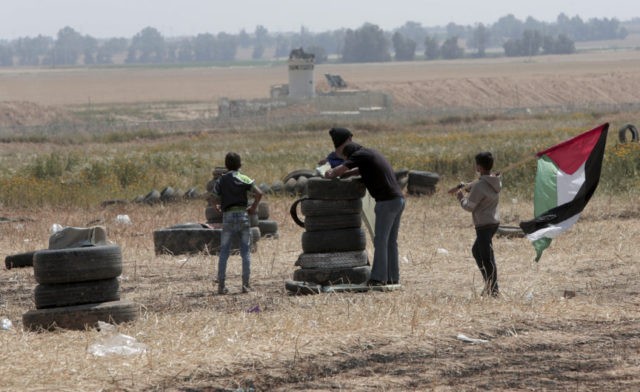KHUZAA, Gaza Strip (AP) — Palestinians torched tires near Gaza’s border with Israel on Friday, sending huge plumes of black smoke into the air and drawing tear gas and live fire from Israeli soldiers deployed on the other side of the border fence.
At least 12 protesters were reported wounded.
Under the cover of smoke, dozens of protesters approached the fence in one area, despite warnings by the Israeli military that those who did so risked their lives. Activists said they were burning the tires in hopes the acrid smoke would block the view of Israeli snipers.
Israel’s military sprayed a thick liquid from water cannons toward the fence, apparently to douse the flames.
A dozen people were wounded by live fire, according to reports from medics and a news website run by Gaza’s ruling Hamas movement.
This included 10 who arrived at a field hospital set up near the border community of Khuzaa, in one of five tent camps for protesters.
Mohammed Ashour, 20, who had been among the first to set tires on fire, had been shot in the right arm. He rested on a stretcher placed on the ground.
“We came here because we want dignity,” he said before paramedics carried him to an ambulance to be transported to the strip’s main hospital.
Earlier in the day, hundreds of Palestinians had streamed to the five tent camps for what Hamas hoped would be the second mass protest in a week.
Last Friday, more than a dozen protesters were killed by Israeli fire and hundreds injured, Gaza health officials said.
Yehia Abu Daqqa, a 20-year-old student, said he had come to demonstrate and honor those killed in the past.
“Yes, there is fear,” he said of the risks of advancing toward the fence. “We are here to tell the occupation that we are not weak.”
Protesters also moved toward other camps, including east of Gaza City, where a senior Hamas leader, Mahmoud Zahar, greeted the crowd.
Friday’s march is the second in what Gaza’s Hamas rulers said would be several weeks of protests against a decade-old border blockade of the territory.
Israel has accused Hamas of trying to carry out border attacks under the cover of large protests and said it will prevent a breach of the fence at all costs.
Israel’s defense minister has warned that protesters approaching the border fence endanger their lives, drawing condemnation from rights groups that said such seemingly broad open-fire rules are unlawful.
A leading Israeli rights group, B’Tselem, issued a rare appeal to Israeli soldiers to refuse “grossly illegal” orders to fire at unarmed protesters.
A White House envoy urged Palestinians to stay away from the fence. Jason Greenblatt said the United States condemns “leaders and protesters who call for violence or who send protesters — including children — to the fence, knowing that they may be injured or killed.”
Last Friday, thousands of Gaza residents participated in the demonstration, many gathering in five tent encampments that had been set up from north to south along the narrow coastal strip’s border with Israel, each at a distance of about several hundred meters from the fence. Smaller groups, mostly young men, rushed forward, throwing stones, hurling firebombs or burning tires and drawing Israeli fire.
In all, 22 Palestinians were killed in Gaza over the past week, among them 16 involved in last Friday’s protests, according to Gaza health officials. This includes a 30-year-old who died on Friday of injuries sustained last week, the officials said.
The six other deaths included three gunmen killed in what Israel said were attempts to attack the border and three men who were struck by Israeli tank fire.
Last week’s turnout was apparently driven by the organizational prowess of Hamas as well as the growing desperation of Gaza residents who live in what has been described as the world’s largest open-air prison.
The crowd size was seen as a test for Hamas, an Islamic militant group that seized the territory in 2007 from its political rival, Palestinian President Mahmoud Abbas.
Ahead of Friday’s march, Hamas announced it would pay compensation to families of those killed or injured, ranging from $200 to $500 per injury and $3,000 per death.
Late Thursday, activists urged residents over loudspeakers mounted on vans touring the streets to show up for what they called the “Friday of Tires.”
The idea of mass protests was initially floated by social media activists, but was later co-opted by Hamas, with the backing of smaller militant factions.
For Hamas, it’s perhaps the last chance to break a border blockade enforced by Israel and Egypt since 2007, without having to succumb to demands that it disarm.
The blockade has made it increasingly difficult for Hamas to govern. It has also devastated Gaza’s economy, made it virtually impossible for people to enter and exit the territory and left residents with just a few hours of electricity a day.
Hamas leaders billed the final protest, set for May 15, as the “Great March of Return” of Palestinian refugees and their descendants, implying they would try to enter Israel. But they stopped short of specifically threatening a mass breach of the border fence.
Israel has warned that it will not permit a breach of the fence and said it has a right to defend its sovereign border.
Military officials have said Hamas has used the protests as a cover for damaging the fence, planting explosives and, in one incident, opening fire on soldiers.
Israel argues that Hamas could have ended the suffering of Gaza’s 2 million people by disarming and renouncing violence.
Hamas has refused to give up its weapons — even at the cost of derailing talks on getting Abbas to assume the burden of governing Gaza, seen by Israel and Egypt as a prerequisite for opening Gaza’s borders.
___
Associated Press writers Karin Laub and Mohammed Daraghmeh in Ramallah, West Bank, contributed to this report.

COMMENTS
Please let us know if you're having issues with commenting.